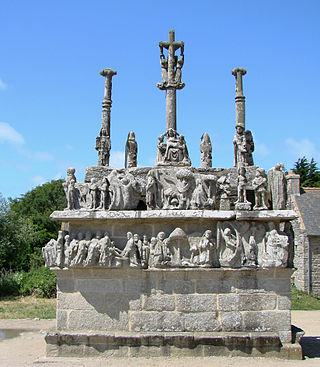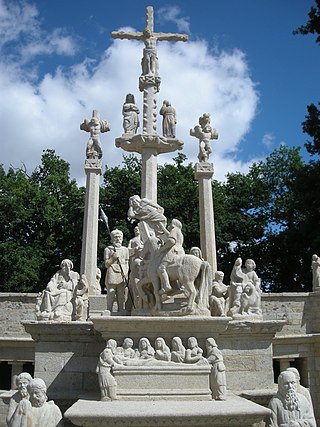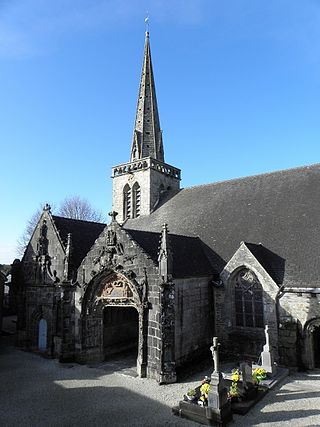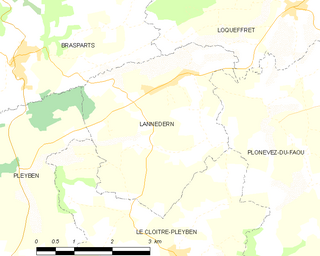Roland Doré was a 17th-century sculptor and his workshop or "atelier" produced many sculptures for the enclos paroissiaux or "parish church enclosure or closes" of Brittany. In particular his work can be seen on calvaries and in the church's south porch. He was born in 1616 and died in 1660. Little detail of his life is known but it is recorded that he practised as an architect in Landerneau, as well as running his workshop, and was recorded as calling himself the "Sculpteur du Roi". His works, all of an ecclesiastical nature, are mainly located in Léon and the north of Cornouaille. They can be taken as works by Doré's workshop rather than just by Doré himself. Brittany is particularly rich in calvaries, some of a very elaborate nature. In most cases the calvary involves both the crucifixion cross and side crosses or gibbets bearing the good and the bad robbers. Below this, on the crosspieces, were statues of those present at the crucifixion. A feature of Breton calvaries is that most of the statues were carved as a pair and effectively back to back. Doré's output was prodigious and he worked on nine monuments in Saint-Thégonnec, five in Logonna-Daoulas and four in the parish of Plougastel-Daoulas. He also received four commissions to work in Hanvec, three in Guiclan, Irvillac and Lampaul-Guimiliau and two commissions in Cléden-Cap-Sizun, Hôpital-Camfrout, Landerneau, La Martyre, Plabennec, Pleyben, Plogonnec, Saint-Nic, Saint-Servais and Saint-Urbain.

The Calvary at Kergrist-Moëlou in the Arrondissement of Guingamp in Brittany, France, dates back to 1578. It was the work of the sculptor Guillaume Jézéquel except for the crucifix which was the work of the sculptor Yves Hernot de Lannion and was remounted on the calvary in 1896. Kergrist-Moëlou is located in the Côtes-d'Armor region, the ancient diocese of Cornouaille. Jézéquel had worked alongside his brother on the Kergrist-Moëlou church in 1554. Originally the calvary's sculpture was substantial, with records showing that it was decorated with almost one hundred statues telling the story of the life and death of Jesus Christ, but the calvary was vandalized during the 1793 French Revolution leaving many statues broken and decapitated with others disappearing completely. What is now left of the calvary stands on a large octagonal granite base and fragments of the mutilated figures are placed around the cross itself. This article gives some of the history of the calvary and describes its constituent parts.
The Calvary of Plougastel-Daoulas in the arrondissement of Brest comprises a raised octagonal pedestal made from the yellow granite of Logonna-Dāaoulas, flanked by four thick arched buttresses. All the sculptural work is by the Maître de Plougastel except the horseman on the left of the crucifix which is by Millet. It is a listed historical monument since 1889.

Calvary at Tronoën is a calvary located at Saint-Jean-Trolimon in the Quimper arrondissement. It is located in the "pays bigouden", a particularly wind swept area of Brittany; the nearby chapelle was called the "cathédrale des dunes".

The Calvary of Guéhenno, dating from 1550, is located in the village of Guéhenno in the Pontivy arrondissement of Brittany. This article gives a full description of the calvary and details of how it was rebuilt after suffering severe damage in 1794. This calvary is classified as one of the seven great calvaries of Brittany and is the furthest to the east, being located in the ancient diocese of Vannes. It is made entirely from granite save for some bas-reliefs carved using "pierre bleutėe". The granite used is fine grained which lends itself to being carved. Extracted from the Guéhenno region, it was also used for the north porch at Ploërmel and the façade of the château at Josselin.

The Calvary at Pleyben, dating from 1555, is located in the village of Pleyben in Brittany, northwestern France.

The Calvary at Plougonven is located within Brittany, France.
The Calvary at Saint-Thégonnec is part of the enclosure of the parish church of Notre-Dame in Saint-Thégonnec. Erected in 1610 it is the last of the monumental calvaries of Brittany. See also Saint-Thégonnec Parish close.

The Saint-Herbot Parish close is a religious complex outside the village Plonévez-du-Faou, Finistère, Brittany in north-western France. It is located on the road between Huelgoat and Loqueffret. The parish close contains the chapel of Saint-Herbot, the calvary and a small ossuary.

The La Martyre Parish close is located in the arrondissement of Brest in Brittany in north-western France. The La Martyre complex comprises the parish church dedicated to Saint Salomon, a "porte triomphale" and an ossuary/chapel. It was founded by the Rohan family and replaced an earlier church which had been called "Notre Dame du Merzer". The church is dedicated to the Breton King Salomon. Much of the church was restored after storm damage in 1450 but the ossuary is of a much later date, being built in 1619. The outstanding features are the south porch which is essentially flamboyant Gothic in style with a decorated entrance arch, the "porte triomphale" entrance and the ossuary. Inside the church there are some notable furnishings. The village owes its name to the assassination on 25 June 874 of King Salomon of Brittany, who had sought refuge in the village church. The church was called "la Martyre" after its desecration, and the name was taken up by the village. As for the king, he was canonised in 910 for his martyrdom. The church, the cemetery gate, the calvary and the former chapel are a listed historical monument since 1916.

The Le Tréhou Parish close is located at Le Tréhou in the arrondissement of Brest in Brittany in north-western France. The parish close was first established in 1555 then reconstructed in the 17th century and reworked in the 18th century. The church, the Église Sainte-Pitère, is dedicated to Saint Pitère and is shaped in the form of a Latin cross. The south porch was added in 1610, with a statue of Saint Pitère over the entrance. The nave has six transepts and aisles with two lateral chapels forming a faux transept. The enclos paroissial is distinguished first and foremost by the architectural quality of the church with its 1649 Renaissance double-galleried bell tower. The calvary is a listed historical monument since 1926.

The Ploudiry Parish close is an enclos paroissial located at Ploudiry within the arrondissement of Brest, Brittany. It comprises a church, ossuary, and calvary. The Parish close was built between the 1630s and 1650s, with major renovations taking place in the 18th and 19th centuries.

The Lampaul-Guimiliau Parish close is located at Lampaul-Guimiliau in the arrondissement of Morlaix in Brittany in north-western France. It is a monumental churchyard belonging to the Église Notre-Dame in that town. This church was built in the late 16th century to replace an older one. The structures in the parish close date to the 16th and 17th century. It is a listed historical monument since 1910.

The Saint-Thégonnec Parish close is located at Saint-Thégonnec in the arrondissement of Morlaix in Brittany in north-western France. The enclos paroissial comprises the parish church of Notre-Dame, a triumphal arch and enclosure wall, an ossuary and the famous calvary. It is a listed historical monument. There is a second calvary set into the enclosure wall and the war memorial dedicated to those lost in the 1914-1918 war is also set into another section of the wall.

The Guimiliau Parish close is located at Guimiliau in the arrondissement of Morlaix in Brittany in north-western France. The parish takes its name from Saint Miliau who was beheaded in 792 on his brother's orders. He is a saint called upon by those suffering from ulcers and rheumatism.

The Pleyben Parish close is a historical cathedral complex at Pleyben in the Châteaulin arrondissement of Brittany in northwestern France. The enclosed paroissial comprises the parish church dedicated to Saint Germain of Auxerre, a funeral chapel/ossuary, a triumphal arch serving as the enclosed entrance, and the Calvary at Pleyben. The building is dominated by two bell towers. The rightmost, known as the Saint Germain, is in the Renaissance style and is topped by a lanterned dome; whilst the other has a Gothic style spire. Between the towers is a stair turret with pinnacles and an ornate spire. The close is a listed historical monument since 1846.

The Locmélar Parish close is located at Locmélar in the arrondissement of Morlaix in Brittany in north-western France. It is a listed historical monument since 1934.

The Lannédern Parish close is located at Lannédern in the Châteaulin arrondissement within Brittany in north-western France. The parish close comprises the parish church of Saint-Edern dating to the 16th/17th century and the Saint Anne chapel, originally an ossuary. The church's south porch dates to 1662, the pulpit is 17th century as is the altar and altarpiece. The ossuary stands to the west of the church. The church, calvary and ossuary are listed historical monuments since 1915.






































